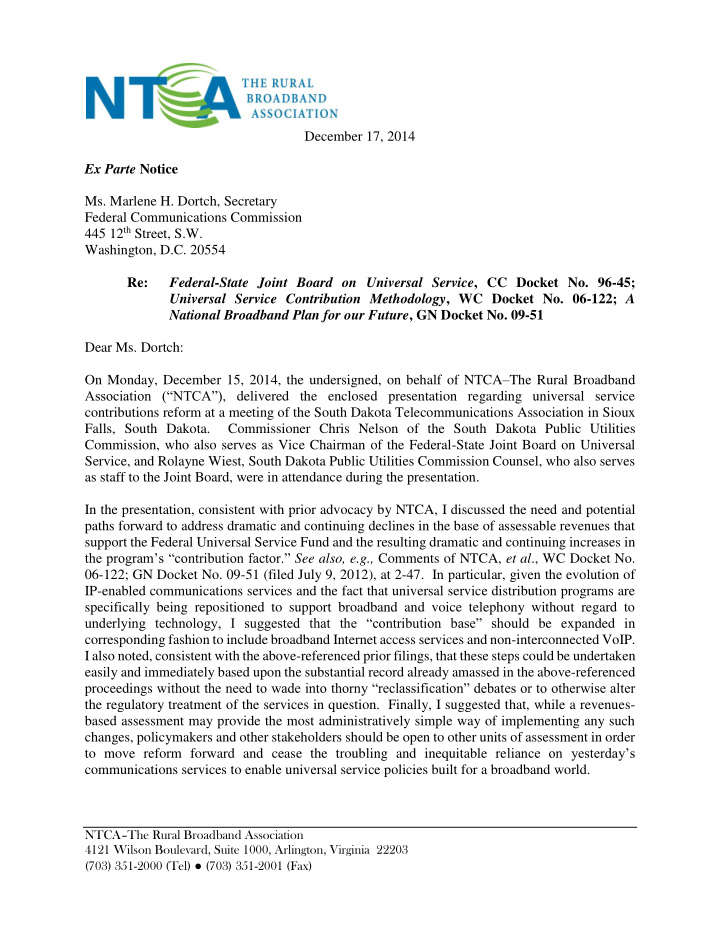



December 17, 2014 Ex Parte Notice Ms. Marlene H. Dortch, Secretary Federal Communications Commission 445 12 th Street, S.W. Washington, D.C. 20554 Re: Federal-State Joint Board on Universal Service , CC Docket No. 96-45; Universal Service Contribution Methodology , WC Docket No. 06-122; A National Broadband Plan for our Future , GN Docket No. 09-51 Dear Ms. Dortch: On Monday, December 15, 2014, the undersigned, on behalf of NTCA – The Rural Broadband Association (“NTCA”) , delivered the enclosed presentation regarding universal service contributions reform at a meeting of the South Dakota Telecommunications Association in Sioux Falls, South Dakota. Commissioner Chris Nelson of the South Dakota Public Utilities Commission, who also serves as Vice Chairman of the Federal-State Joint Board on Universal Service, and Rolayne Wiest, South Dakota Public Utilities Commission Counsel, who also serves as staff to the Joint Board, were in attendance during the presentation. In the presentation, consistent with prior advocacy by NTCA, I discussed the need and potential paths forward to address dramatic and continuing declines in the base of assessable revenues that support the Federal Universal Service Fund and the resulting dramatic and continuing increases in the program’s “contribution factor.” See also, e.g., Comments of NTCA, et al ., WC Docket No. 06-122; GN Docket No. 09-51 (filed July 9, 2012), at 2-47. In particular, given the evolution of IP-enabled communications services and the fact that universal service distribution programs are specifically being repositioned to support broadband and voice telephony without regard to underlying technology, I suggested that the “contribution base” sho uld be expanded in corresponding fashion to include broadband Internet access services and non-interconnected VoIP. I also noted, consistent with the above-referenced prior filings, that these steps could be undertaken easily and immediately based upon the substantial record already amassed in the above-referenced proceedings without the need to wade into thorny “reclassification” debates or to otherwise alter the regulatory treatment of the services in question. Finally, I suggested that, while a revenues- based assessment may provide the most administratively simple way of implementing any such changes, policymakers and other stakeholders should be open to other units of assessment in order to move reform forward and cease the troubling and inequitable re liance on yesterday’s communications services to enable universal service policies built for a broadband world. NTCA – The Rural Broadband Association 4121 Wilson Boulevard, Suite 1000, Arlington, Virginia 22203 (703) 351-2000 (Tel) ● (703) 351-2001 (Fax)
Marlene H. Dortch December 17, 2014 Page 2 of 2 Thank you for your attention to this correspondence. Pursuant to Section 1.1206 of the Commission’s rules, a copy of this letter is being filed via ECFS. Sincerely, /s/ Michael R. Romano Michael R. Romano Senior Vice President – Policy Enclosure cc: Commissioner Chris Nelson Rolayne Wiest, Esq.
Perspectives on USF Contributions Reform December 2014 Mike Romano Senior Vice President – Policy NTCA
Demand – High Cost ($4.5B Cap) Distributions (in millions) 4600 4400 4200 4000 2007 2008 2009 2010 2011 2012 2013 2014
Demand – Rural Health Care ($400M Cap) Distributions (in millions) 250 230 210 190 170 150 130 110 90 2007 2008 2009 2010 2011 2012 2013 2014
Demand – Low-Income (No Cap) Distributions (in millions) 2350 2150 1950 1750 1550 1350 1150 950 750 2007 2008 2009 2010 2011 2012 2013 2014
Demand – E-rate ($3.75B Cap + inflation index) Distributions (in millions) 3700 3500 3300 3100 2900 2700 2500 2300 2100 1900 2007 2008 2009 2010 2011 2012 2013 2014 2015?
Supply Contribution Base (in millions) 70000 65000 60000 55000 50000 2007 2008 2009 2010 2011 2012 2013 2014
Contribution Factor Assessable % of Revenues 17 16 15 14 13 12 11 10 2007 2008 2009 2010 2011 2012 2013 2014
Supply without Reform Going Forward (assumes avg. of last 3 years as continued annual reduction) Contribution Base (in millions) 70000 65000 60000 55000 50000 45000
Fixing USF Supply • We can dramatically improve the Supply equation – effective immediately – by expanding the Contribution Base just to include : – Fixed & Mobile Retail Broadband Internet Access Revenues – Est. $122B Market combined in 2012* – Texting Revenues – Est. $20B Billion Market** – Non-Interconnected (1-way) VoIP Service Revenues Source s: * ABI Research (Feb. 2013); Chetan Sharma (Mar. 2013) ** Time Magazine (Nov. 2012)
Supply with Reform Going Forward (assumes avg. of last 3 years as continued annual reduction, plus inclusion of new revenues as of 2015 with 2.5% annual increase therein thereafter) Contribution Base (in millions) 250000 200000 150000 100000 50000 0
Broadening the Base Has To Mean Something • Quarterly factors have fluctuated wildly – between 12.9% and 17.8% just since 2010 • Sends bad signals to purchasers of services and unsustainable as a matter of policy • If we had Supply with Reform tomorrow, and assumed no increase in USF distributions, the Quarterly Contribution Factor for Q1 2015 could be approx. 1.4% rather than 16.8% . • Average customer’s broadband assessment would equal: • For 10/1 = $1.20 per month • For 4/1 = $1.04 per month • Meanwhile, average customer’s voice assessment would reduce from $3.43 to $0.28 (or even lower)
What Now? • Joint Board • 2012 repeat or something more? • Industry Politics • Telecom segments • Net-centric businesses • Consumer groups • What Can’t Happen – Nothing . . .
Supply without Reform Going Forward (assumes avg. of last 3 years as continued annual reduction) Contribution Base (in millions) 70000 65000 60000 55000 50000 45000
So What are the Options (Other than Nothing)? • Revenues • Pros: Simple to administer; builds upon existing system • Cons: Politics; builds upon existing system . . . • Connections • Pros: Gets to heart of network use • Cons: Not as easy to administer – speed, capacity, intercarrier? • Numbers • Pros: Really simple to administer • Cons: Backward-looking, especially in an IP/BB world • Hybrids?
Recommend
More recommend